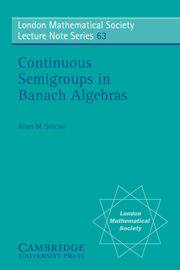Book contents
- Frontmatter
- Contents
- 1 Introduction and preliminaries
- 2 Analytic semigroups in particular Banach algebras
- 3 Existence of analytic semigroups – an extension of Cohen's factorization method
- 4 Proof of the existence of analytic semigroups
- 5 Restrictions on the growth of ∥at∥
- 6 Nilpotent semigroups and proper closed ideals
- Appendix 1 The Ahlfors-Heins theorem
- Appendix 2 Allan's theorem – closed ideals in L1 (ℝ+, ω)
- Appendix 3 Quasicentral bounded approximate identities
- References
- Index
1 - Introduction and preliminaries
Published online by Cambridge University Press: 22 March 2010
- Frontmatter
- Contents
- 1 Introduction and preliminaries
- 2 Analytic semigroups in particular Banach algebras
- 3 Existence of analytic semigroups – an extension of Cohen's factorization method
- 4 Proof of the existence of analytic semigroups
- 5 Restrictions on the growth of ∥at∥
- 6 Nilpotent semigroups and proper closed ideals
- Appendix 1 The Ahlfors-Heins theorem
- Appendix 2 Allan's theorem – closed ideals in L1 (ℝ+, ω)
- Appendix 3 Quasicentral bounded approximate identities
- References
- Index
Summary
INTRODUCTION
The theory of analytic (one parameter) semigroups t ↦ at from the open right half plane H into a Banach algebra is the main topic discussed in these notes. Several concrete elementary classical examples of such semigroups are defined, a general method of constructing such semigroups in a Banach algebra with a bounded approximate identity is given, and then relationships between the semigroup and the algebra are investigated. These notes form small sections in the theory of (one parameter) continuous semigroups and in the general theory of Banach algebras. They emphasize an approach that is standard to neither of these subjects. A study of Hille and Phillips [1974] reveals that the theory of Banach algebras has been used as a tool in the study of certain problems in continuous semigroups, but that semigroup theory has until recently (1979) not impinged on the theory of Banach algebras. These lecture notes are about this recent progress.
Throughout these notes we use ‘semigroup’ for ‘one parameter semigroup’ when discussing a homomorphism from an additive subsemigroup of ℂ into a Banach algebra, and we write our semigroups t ↦ at to emphasize the power law at+s = at · as and function property of the semigroup. In the standard works on semigroups much attention is given to strongly continuous semigroups and their generators (see Hille and Phillips [1974], Dunford and Schwartz [1958], and Reed and Simon [1972]). In these works the generator itself is important, plays a fundamental role, and is often an object of considerable mathematical interest (for example, it may be the Laplacian).
- Type
- Chapter
- Information
- Continuous Semigroups in Banach Algebras , pp. 1 - 11Publisher: Cambridge University PressPrint publication year: 1982



